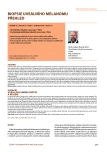Evaluation of Patients Presenting to the Ophthalmology Department of a Tertiary Hospital for Nonemergency Reasons During the Covid-19 Pandemic
Autoři:
Aslan Fatih 1; Öktem Lar A 1
Působiště autorů:
Alaaddin Keykubat University Alanya Education and Research Hospital, Department of Ophthalmology Antalya, TURKEY
1
Vyšlo v časopise:
Čes. a slov. Oftal., 76, 2020, No. 6, p. 260-264
Kategorie:
Originální práce
doi:
https://doi.org/10.31348/2020/36
Souhrn
Objective: To evaluate changes in the demographic and diagnostic distribution of patients presenting to the ophthalmology department during the COVID-19 pandemic, compared to the pre-pandemic period.
Methods: The study included patients who made outpatient appointments in our ophthalmology department. The COVID-19 group (CovG) comprised patients who presented between April 15 and May 15, 2020, the 30-day period with the highest daily number of new cases in Turkey. The control group (CG) was obtained by randomization through a computer program from among 2 245 patients who applied in the same period of the previous year. The patients’ presenting complaint(s), diagnostic(s) and demographic information’s were collected from a database, with all identifying information concealed. For patients who presented more than once, their initial complaint and diagnoses were analyzed.
Results: The study included a total of 400 patients: 200 in the CovG and 200 in the CG. Mean ages in the CovG and CG were 41.23±14.48 and 48.20±17.49 years, respectively (p<0.001). The female to male patient ratio was 0.53 in the CovG and 0.83 in the CG (p=0.032). There were fewer university graduates compared to other education levels among the patients who presented during the pandemic (p=0.013). During the COVID-19 pandemic, there was no increase in presentation frequency for any ocular disease compared to the previous year.
The only statistical decrease in patient application complaints was observed in reading difficultness (11 % in CovG vs. 37 % in CG; p<0.001). Presentations due to dry eye (DE) and allergic conjunctivitis (AC) were similar to the same period of the year (p=0.303 and p=0.550, respectively). At least 1 chronic ocular disease was present in 25 % of the CovG and 45.5 % of the CG (p<0.001). A statistically significant decrease was observed in CovG for age-related macular degeneration and glaucoma in the diagnoses made at the end of the examination (p=0.001 and p<0.001, respectively).
Conclusion: During the first peak of the COVID-19 pandemic in Turkey, the most common outpatient presentations to the ophthalmology department were for the diagnoses of DE and AC. During peak pandemic period, elderly patients, women and academically trained patients significantly reduced their visits to the Eye Clinic. The reduction in presentation of patients with glaucoma and age-related macular degeneration may be due to the long-term treatment planning for these patients and the social isolation measures issued for the older population. These patients should be encouraged to use video consultation / telemedicine in eye patients at risk of vision loss.
Klíčová slova:
COVID-19 – pandemic – ophthalmological diseases – diagnosis distribution – Epidemiology – risk perception
Zdroje
- Guo YR, Cao QD, Hong ZS, et al. The origin, transmission and clinical therapies on coronavirus disease 2019 (COVID-19) outbreak - an update on the status. Mil Med Res. 2020;7:11.
- Republic of Turkey Ministry of Health, General Directorate of Public Health. COVID-19 (SARS-CoV2 Infection) Guide (Science Board Study): General information, epidemiology and diagnosis. Republic of Turkey Ministry of Health website. June 1,2020. Accessed June 4, 2020. https://covid19bilgi.saglik.gov.tr/depo/rehberler/covid-19-rehberi/COVID-19_REHBERI_GENEL_BILGILER_EPIDEMIYOLOJI_VE_TANI.pdf
- Global surveillance for COVID-19 caused by human infection with COVID-19 virus: interim guidance. World Health Organization; March 20, 2020.
- https://www.icisleri.gov.tr/65-yas-ve-ustu-ilekronik-rahatsizligi-olanlara-sokaga-cikmayasagi-genelgesi. 21.03.2020.
- https://www.icisleri.gov.tr/koronavirus-tedbirleri-genelgesi-kapsaminda-149382-is-yerigecici-sureligine-faaliyetlerine-ara-verdi.
- Important coronavirus updates for ophthalmologists. American Academy of Ophthalmology website. https://www.aao.org/headline/alert-important-coronavirus-context. Updated March 25, 2020. Accessed March 29, 2020.
- Bozkurt B, Eğrilmez S, Şengör T, Yıldırım Ö, İrkeç M. The COVID-19 Pandemic: Clinical Information for Ophthalmologists. Turk J Ophthalmol. 2020;50:59-63
- Xia J, Tong J, Liu M, Shen Y, Guo D. Evaluation of coronavirus in tears and conjunctival secretions of patients with SARS-CoV-2 infection. J Med Virol. 2020 Feb 26. doi: 10.1002/jmv.25725.
- Lu C-w, Liu X-f, Jia Z-f. 2019-nCoV transmission through the ocular surface must not be ignored. Lancet. 2020;395:e39.
- Jun ISY, Anderson DE, Kang AEZ. Assessing Viral Shedding and Infectivity of Tears in Coronavirus Disease 2019 (COVID-19) Patients. Ophthalmology. 2020;127:977-979.
- Seah I, Agrawal R. Can the coronavirus disease 2019 (COVID-19) affect the eyes? A review of coronaviruses and ocular implications in humans and animals. Ocul Immunol Inflamm. 2020;28:391-395.
- Turan Ç, Metin N, Utlu Z, Öner Ü, Kotan ÖS. Change of the diagnostic distribution in applicants to dermatology after COVID-19 pandemic: What it whispers to us? Dermatol Ther. 2020 Jun 12:e13804. doi: 10.1111/dth.13804.
- Cengiz AB, Tansuker HD, Oktay MF. The Features of the Patients Who Attend to Otorhinolaryngology Outpatient Clinics in the First Days of the COVID-19 Outbreak in Turkey? KBB ve BBC Dergisi. 2020 May 12. doi: 10.24179/kbbbbc.2020-76082. Turkish.
- Wu M, Liu X, Han J, Shao T, Wang Y. Association Between Sleep Quality, Mood Status, and Ocular Surface Characteristics in Patients With Dry Eye Disease. Cornea. 2019 Mar;38:311-317. doi: 10.1097/ICO.0000000000001854.
Štítky
OftalmologieČlánek vyšel v časopise
Česká a slovenská oftalmologie

2020 Číslo 6
- Stillova choroba: vzácné a závažné systémové onemocnění
- Diagnostický algoritmus při podezření na syndrom periodické horečky
- Oční vyšetření a možnosti léčby v ordinaci praktického lékaře
- Kontaktní dermatitida očních víček
- Sjögrenův syndrom jako příčina syndromu suchého oka
Nejčtenější v tomto čísle
- MŮŽE OTEVŘENÉ FORAMEN OVALE OVLIVNIT ZRAKOVÉ FUNKCE?
- ZRAKOVÉ FUNKCE PO IMPLANTACI MONOFOKÁLNÍCH NITROOČNÍCH ČOČEK ACRYSOF
- POZDNÍ FUNKČNÍ A MORFOLOGICKÉ NÁLEZY PO OTRAVĚ METYLALKOHOLEM.
- BIOPSIE UVEÁLNÍHO MELANOMU PŘEHLED
